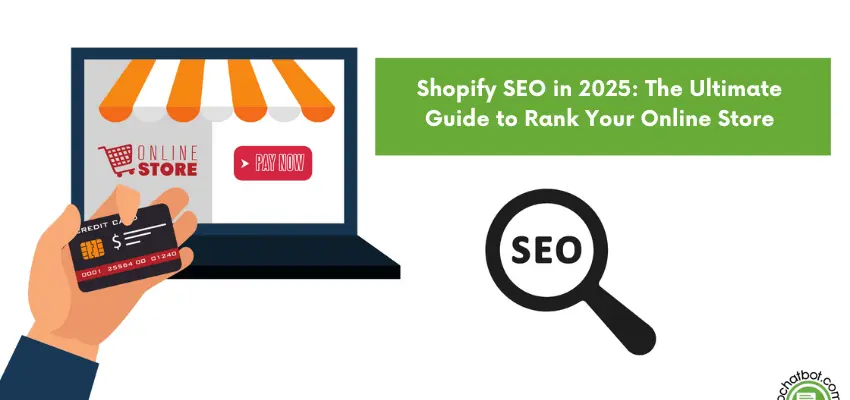With over 4 million merchants using Shopify, standing out in search results has never been more crucial. Shopify SEO is the key to driving organic traffic, increasing conversions, and growing your business without relying solely on paid ads. In this comprehensive 2025 guide, we’ll walk you through actionable strategies to optimize your Shopify store for higher Google rankings and long-term success.
👉 Want to boost your Shopify store’s visibility? Get a Free Website Audit! 🚀

Why Shopify SEO Matters in 2025
With more competition and evolving Google algorithms, ignoring SEO could cost you potential sales. Organic traffic converts 2.5x better than paid ads. Investing in Shopify SEO ensures your store ranks higher, attracts qualified leads, and reduces customer acquisition costs.
✅ Increase Visibility: Rank above competitors and get noticed by potential customers.
✅ Long-Term ROI: Organic rankings provide sustained traffic without ongoing ad spend.
✅ Improved User Experience: SEO optimizations also enhance site usability and speed.
✅ Higher Conversion Rates: SEO targets high-intent shoppers ready to buy.
Step-by-Step Shopify SEO Guide
1. Conduct In-Depth Keyword Research
The foundation of effective Shopify SEO is choosing the right keywords. Focus on transactional and long-tail keywords with buying intent.
✅ Use tools like Ahrefs, SEMRush, or Ubersuggest to find keywords.
✅ Prioritize keywords with high search volume and low competition.
✅ Target keywords specific to your products (e.g., “eco-friendly yoga mats UAE”).
👉 Pro Tip: Use keywords naturally in titles, descriptions, and content. Avoid keyword stuffing.
2. Optimize Your Shopify Store Structure
A clean, organized site structure makes it easier for search engines to crawl and users to navigate.
✅ Create a simple URL hierarchy:
Homepage → Collections → Products
✅ Use descriptive URLs (e.g.,/collections/organic-clothinginstead of/collections/12345).
✅ Implement breadcrumb navigation to improve user experience and SEO.
✅ Add a comprehensive XML sitemap and submit it to Google Search Console.
➡️ Learn more about site architecture: SEO-Friendly Website Architecture
3. Improve On-Page SEO for Shopify Pages
Optimizing individual pages ensures they rank for targeted keywords.
✅ Title Tags & Meta Descriptions:
Include target keywords naturally and keep them relevant to the page content.
Limit title tags to 60 characters and meta descriptions to 155 characters for optimal display in SERPs.
✅ Header Tags (H1, H2, H3):
Use headers to break content into sections for better readability and to help search engines understand page hierarchy. Ensure there is only one H1 tag per page, with subsequent sections using H2 and H3 tags.
✅ Product Descriptions:
Write unique, engaging descriptions that highlight product benefits and address customer pain points.
Avoid duplicating manufacturer content to prevent duplicate content penalties.
➡️ Need help with crafting product descriptions? SEO-Friendly Product Descriptions Guide
✅ Optimize Images:
Compress images to improve page load times and enhance user experience.
Use descriptive alt text (e.g., “Organic cotton t-shirt in UAE”) for better accessibility and image SEO.
✅ Internal Linking:
Link to related products and blog posts to help users discover more content and improve crawlability.
Example: “Explore our best-selling eco-friendly bags.”
4. Technical SEO Optimizations
Ensure your Shopify store’s backend is optimized for search engines.
✅ Site Speed:
Compress images to reduce file sizes without compromising quality.
Remove unnecessary Shopify apps that slow down your store.
Choose a fast and optimized Shopify theme designed for performance.
✅ Mobile Optimization:
Over 60% of traffic comes from mobile devices.
Use responsive designs that adapt seamlessly to different screen sizes.
Test your store with Google’s Mobile-Friendly Test tool to ensure usability.
✅ Secure Your Site with HTTPS:
SSL certificates are a ranking factor and build customer trust.
Ensure all pages redirect from HTTP to HTTPS to avoid mixed content issues.
✅ Fix Broken Links & Redirects:
Regularly audit your site for broken links and outdated pages.
Use 301 redirects to direct users and search engines to the correct pages.
➡️ Read our guide: Redirects for SEO
✅ Implement Structured Data (Schema):
Add schema markup for products, reviews, and breadcrumbs to enhance rich snippets in search results.
Use tools like Google’s Structured Data Testing Tool to verify proper implementation.
5. Content Marketing: Blog Your Way to Better Rankings
Creating valuable content attracts organic traffic and builds authority.
✅ Start a blog addressing customer pain points and product usage tips.
✅ Use long-tail keywords and answer common questions.
✅ Example posts: “How to Style Organic Cotton Dresses” or “Why Choose Eco-Friendly Yoga Mats?”
✅ Include a CTA (Call to Action) in every post.
➡️ Learn how SEO and content marketing work together.
6. Build High-Quality Backlinks
Backlinks from reputable sites signal trust and authority to search engines.
✅ Guest Blogging: Write articles for relevant industry blogs.
✅ Product Reviews & Influencers: Send products to influencers for reviews.
✅ Local Citations: Get listed in local directories.
✅ Competitor Analysis: Use tools to find backlink opportunities.
➡️ Check out our Link Building Hacks Nobody Talks About.
7. Monitor Performance & Refine Your Strategy
Tracking your SEO efforts ensures continuous improvement.
✅ Use Google Analytics 4 to monitor traffic and conversions.
✅ Check Google Search Console for indexing and technical issues.
✅ Regularly audit your site for improvements.
➡️ Follow our SEO Audit Guide to stay ahead.
FAQs
Q1: How long does it take to see results from Shopify SEO?
SEO is a long-term strategy. Expect noticeable results within 3-6 months with consistent efforts.
Q2: Should I focus on paid ads or SEO?
Both are valuable. Use SEO for sustainable long-term growth and ads for immediate traffic boosts.
Q3: Can I do Shopify SEO myself, or should I hire an expert?
You can start on your own, but working with an SEO agency ensures faster, more effective results.
➡️ Contact us for expert help.
Q4: How important is mobile optimization for Shopify SEO?
Crucial! Over 60% of shoppers use mobile devices, and Google prioritizes mobile-first indexing.
Conclusion
Shopify SEO is essential for online store success in 2025. By focusing on keyword research, technical optimizations, quality content, and backlink building, you’ll position your store for higher rankings and increased sales.
Ready to skyrocket your Shopify store’s visibility? Get your Free Website Audit now! 🚀
